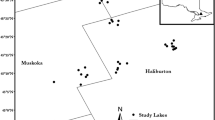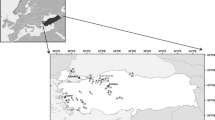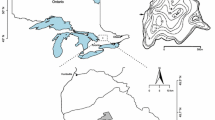Abstract
We compared contemporary and pre-Industrial Age (before 1850 AD) fossil assemblages of Cladocera in sediment cores from 25 lakes in the Italian and Swiss Alps to investigate the impact of mounting anthropogenic stresses over the last 150 years on community composition. In addition, we sought relationships between specific species and their environments by measuring nutrients, major ions, pH, alkalinity, conductivity, chlorophyll, and lake and catchment morphological features at the time of core collection for comparison with surface sediment fossil assemblages. The modern (surface sediment) communities of the study lakes consisted mainly of benthic chydorids, primarily Alona affinis, A. quadrangularis, Acroperus harpae, and Chydorus sphaericus-type, with Daphnia as the sole planktonic genus. Principal component analysis (PCA), relating the modern Cladocera assemblages to environmental variables at the time of sampling, indicated that A. affinis and A. quadrangularis are influenced by altitude and dissolved inorganic nitrogen (PCA axis 1) whereas Acroperus harpae and C. sphaericus-type are more influenced by potassium (PCA axis 2). Redundancy analysis, however, identified lake water pH and potassium as the measured variables most impacting modern cladoceran assemblages, and especially the distribution of C. sphaericus-type and A. harpae. Pre-Industrial Age samples contained more Daphnia (longispina-type primarily) than modern samples, and some harbored Eurycercus lamellatus, which has since been extirpated from these lakes. The directional shifts in Cladocera assemblages from the pre-industrial period to the present, illustrated as changes in the sample scores along the PCA axes 1 and 2, were associated with the secondary PCA gradient in almost all lakes, and thus were probably the indirect responses to a cascade of limnological alterations, perhaps initiated by large anthropogenic forcing factors such as atmospheric pollution or fish introductions.




Similar content being viewed by others
References
Amsinck, S. L., E. Jeppesen & F. Landkildehus, 2005. Relationship between environmental variables and zooplankton subfossils in the surface sediments of 36 shallow coastal brackish lakes with special emphasis on the role of fish. Journal of Paleolimnology 33: 39–51.
Amsinck, S. L., A. Strzelczak, R. Bjerring, F. Landkildehus, T. L. Lauridsen, K. Christofferssen & E. Jeppesen, 2006. Lake depth rather than planktivory determines cladoceran community structure in Faroese lakes – evidence from contemporary data and sediments. Freshwater Biology 51: 2124–2142.
Belyaeva, M. & R. Deneke, 2007. Colonization of acidic mining lakes: Chydorus sphaericus and other Cladocera within a dynamic horizontal pH gradient (pH 3–7) in Lake Senftenberger See (Germany). Hydrobiologia 594: 97–108.
Belyaeva, M. & D. J. Taylor, 2009. Cryptic species within the Chydorus sphaericus species complex (Crustacea: Cladocera) revealed by molecular markers and sexual stage morphology. Molecular Phylogenetics and Evolution 50: 534–546.
Bigler, C., O. Heiri, R. Krškova, A. Lotter & M. Sturm, 2006. Distribution of diatoms, chironomids and cladocera in surface sediments of thirty mountain lakes in south-eastern Switzerland. Aquatic Sciences 68: 154–171.
Brancelj, A., M. Kernan, E. Jeppesen, M. Rautio, M. Manca, M. Šiško, M. Alonso & E. Stuhlík, 2009. Cladocera remains from the sediments of remote cold lakes: a study of 294 lakes across Europe. Advances in Limnology 62: 269–294.
Brodersen, K. P., M. C. Whiteside & C. Lindegaard, 1998. Reconstruction of trophic state in Danish lakes using subfossil chydorid (Cladocera) assemblages. Canadian Journal of Fisheries and Aquatic Sciences 55: 1093–1103.
Brooks, J. L. & S. I. Dodson, 1965. Predation, body size, and composition of plankton. Science 150: 28–35.
Cammarano, P. & M. Manca, 1997. Studies on zooplankton in two acidified mountain lakes in the Alps. Hydrobiologia 356: 97–109.
Chen, G., C. Dalton & D. Taylor, 2010. Cladocera as indicators of trophic state in Irish lakes. Journal of Paleolimnology 44: 465–481.
Davidson, T. A., C. D. Sayer, M. R. Perrow, M. Bramm & E. Jeppesen, 2007. Are the controls of species composition similar for contemporary and sub-fossil cladoceran assemblages? A study of 39 shallow lakes of contrasting trophic status. Journal of Paleolimnology 38: 117–134.
Davidson, T. A., C. D. Sayer, P. G. Langdon, A. Burgess & M. Jackson, 2010a. Inferring past zooplanktivorous fish and macrophyte density in a shallow lake: application of a new regression tree model. Freshwater Biology 55: 584–599.
Davidson, T. A., C. D. Sayer, M. R. Perrow, M. Bramm & E. Jeppesen, 2010b. The simultaneous inference of zooplanktivorous fish and macrophyte density from sub-fossil cladoceran assemblages: a multivariate regression tree approach. Freshwater Biology 55: 546–564.
DeSellas, A. M., A. M. Paterson, J. N. Sweetman & J. P. Smol, 2008. Cladocera assemblages from surface sediments of south-central Ontario (Canada) lakes and their relationships to measured environmental variables. Hydrobiologia 600: 105–119.
DeSellas, A. M., A. M. Paterson, J. N. Sweetman & J. P. Smol, 2011. Assessing the effects of multiple environmental stressors on zooplankton assemblages in Boreal Shield lakes since pre-industrial times. Journal of Limnology 70: 41–56.
Eggermont, H., D. Verschuren, L. Audenaert, L. Lens, J. Russell, G. Klaassen & O. Heiri, 2010. Limnological and ecological sensitivity of Rwenzori mountain lakes to climate warming. In Eggermont, H., M. Kernan, & K. Martens (eds), Global Change Impacts on Mountain Lakes. Special Issue, Hydrobiologia 648: 123–142.
Frey, D. G., 1958. The late-glacial cladoceran fauna of a small lake. Archiv für Hydrobiologie 54: 209–275.
Frey, D. G., 1960. The ecological significance of cladoceran remains in lake sediments. Ecology 41: 684–699.
Frey, D. G., 1986. Cladocera analysis. In Berglund, B. E. (ed.), Handbook of Holocene Palaeoecology and Palaeohydrology. John Wiley and Sons, New York: 667–692.
Gąsiorowski, M. & E. Sienkiewicz, 2010. 20th Century acidification and warming as recorded in two alpine lakes in the Tatra Mountains (South Poland, Europe). Science of the Total Environment 408: 1091–1101.
Grimalt, J. O., P. Fernandez, L. Berdie, R. M. Vilanova, J. Catalan, R. Psenner, R. Hofer, P. G. Appleby, B. O. Rosseland, L. Lien, L. C. Massabuau & R. W. Battarbee, 2001. Selective trapping of organochlorine compounds in mountain lakes of temperate areas. Environmental Science and Technology 35: 2690–2697.
Guilizzoni, P., A. Lami & A. Marchetto, 1992. Plant pigment ratios from lake sediments as indicators of recent acidification in alpine lakes. Limnology and Oceanography 37: 1565–1569.
Guilizzoni, P., A. Lami, M. Manca, S. Musazzi & A. Marchetto, 2006a. Palaeoenvironmental changes inferred from biological remains in short lake sediment cores from the Central Alps and Dolomites. Hydrobiologia 526: 167–191.
Guilizzoni, P., A. Marchetto, A. Lami, A. Brauer, L. Vigliotti, S. Musazzi, L. Langone, M. Manca, F. Lucchini, N. Calanchi, E. Dinelli & A. Mordenti, 2006b. Records of environmental and climatic changes during the late Holocene from Svalbard: palaeolimnology of Kongressvatnet. Journal of Paleolimnology 36: 325–351.
Harmsworth, R. V., 1968. The developmental history of Blelham Tarn (England) as shown by animal microfossils, with special reference to the Cladocera. Ecological Monographs 38: 223–241.
Jeppesen, E., P. Leavitt, L. De Meester & J. P. Jensen, 2001. Functional ecology and palaeolimnology: using cladoceran remains to reconstruct anthropogenic impact. Trends in Ecology and Evolution 16: 191–198.
Jeppesen, E., J. P. Jensen, T. P. Lauriden, S. L. Amsinck, K. Christoffersen, M. Søndergaard & S. Mitchell, 2003. Sub-fossils of cladocerans in the surface sediments of 135 lakes as proxies for community structure of zooplankton, fish abundance and lake temperature. Hydrobiologia 491: 321–330.
Jeziorski, A., N. D. Yan, A. M. Paterson, A. M. DeSellas, M. A. Turner, D. S. Jeffries, B. Keller, R. C. Weeber, D. K. McNicol, M. E. Palmer, K. McIver, K. Arsenau, B. K. Ginn, B. F. Cumming & J. P. Smol, 2008. The widespread threat of calcium decline in fresh waters. Science 322: 1374–1377.
Kamenik, C., K. Szeroczyńska & R. Schmidt, 2007. Relationship among recent Alpine Cladocera remains and their environment: implications for climate-change studies. Hydrobiologia 594: 33–46.
Kattel, G. R., R. W. Battarbee, A. Mackay & H. J. B. Birks, 2008. Recent ecological change in a remote Scottish mountain loch: an evaluation of a Cladocera-based temperature transfer-function. Palaeogeography, Palaeoclimatology, Palaeoecology 259: 51–76.
Korhola, A., 1999. Distribution patterns of Cladocera in subarctic Fennoscandian lakes and their potential in environmental reconstruction. Ecography 22: 357–373.
Korhola, A. & M. Rautio, 2001. Cladocera and other Branchiopod Crustaceans. In Smol, J. P., H. J. B. Birks & W. M. Last (eds), Tracking Environmental Change Using Lake Sediments, Vol 4: Zoological Indicators. Kluwer Academic Publishers, Dordrecht: 5–41.
Korhola, A., H. Olander & T. Blom, 2000. Cladoceran and chironomid assemblages as quantitative indicators of water depth in subarctic Fennoscandian lakes. Journal of Paleolimnology 24: 43–53.
Korhola, A., M. Tikkanen & J. Weckström, 2005. Quantification of Holocene lake-level changes in Finnish Lapland using a Cladocera – lake depth transfer model. Journal of Paleolimnology 34: 175–190.
Korosi, J. B. & J. P. Smol, 2011. Distribution of cladoceran assemblages across environmental gradients in Nova Scotia (Canada) lakes. Hydrobiologia 663: 83–99.
Korosi, J. B., A. M. Paterson, A. M. DeSellas & J. P. Smol, 2008. Linking mean body size of pelagic Cladocera to environmental variables in Precambrian Shield lakes: A paleolimnological approach. Journal of Limnology 67: 22–34.
Krause-Dellin, D. & C. Steinberg, 1986. Cladoceran remains as indicators of lake acidification. Hydrobiologia 143: 129–134.
Lotter, A. F., H. J. B. Birks, W. Hofmann & A. Marchetto, 1997. Modern diatom, cladocera, chironomid, and chrysophyte cyst assemblages as quantitative indicators for the reconstruction of past environmental conditions in the Alps. I. Climate. Journal of Paleolimnology 18: 395–420.
Lotter, A. F., H. J. B. Birks, U. Eicher, W. Hofmann, J. Schwander & L. Wick, 2000. Younger Dryas and Allerød summer temperatures at Gerzensee (Switzerland) inferred from fossil pollen and cladoceran assemblages. Palaeogeography, Palaeoclimatology, Palaeoecology 159: 349–361.
Luoto, T. P. & L. Nevalainen, 2011. Inferring reference conditions of hypolimnetic oxygen for deteriorated Lake Mallusjärvi in the cultural landscape of Mallusjoki, southern Finland using fossil midge assemblages. Water, Air, & Soil Pollution 217: 663–675.
Manca, M. & M. Armiraglio, 2002. Zooplankton of 15 lakes in the Southern Central Alps: comparison of recent and past (pre-ca 1850 AD) communities. Journal of Limnology 61: 225–231.
Manca, M. & P. Comoli, 2004. Reconstructing long-term changes in Daphnia’s body size from subfossil remains in sediments of a small lake in the Himalayas. Journal of Paleolimnology 32: 95–107.
Manca, M., D. Ruggiu, P. Panzani, A. Asioli & G. Mura, 1998. Report on a collection of aquatic organisms from high mountain lakes in the Khumbu Valley (Nepalese Himalayas). Memorie dell’Istituto Italiano di Idrobiologia 57: 77–98.
Marchetto, A., R. Mosello, M. Rogora, M. Manca, A. Boggero, G. Morabito, S. Musazzi, G. A. Tartari, A. M. Nocentini, A. Pugnetti, R. Bettinetti, P. Panzani, M. Armiraglio, P. Cammarano & A. Lami, 2004. The chemical and biological response of two remote mountain lakes in the Southern Central Alps (Italy) to twenty years of changing physical and chemical climate. Journal of Limnology 63: 77–89.
Marchetto, A., M. Rogora, A. Boggero, S. Musazzi, A. Lami, A. F. Lotter, M. Tolotti, H. Thies, R. Psenner, J. Massaferro & A. Barbieri, 2009. Response of Alpine lakes to major environmental gradients, as detected through planktonic, benthic and sedimentary assemblages. Advances in Limnology 62: 419–440.
Mosello, R., A. Marchetto, A. Boggero, M. C. Brizzio, G. A. Tartari & M. Rogora, 1999. Pluriannual evolution of the hydrochemistry of two Alpine lakes (Lake Paione Inferiore and Lake Paione Superiore, Ossola Valley) in relation to atmospheric loads. Journal of Limnology 58: 42–48.
Nevalainen, L., K. Sarmaja-Korjonen & T. P. Luoto, 2011. Sedimentary Cladocera as indicators of past water level changes in shallow northern lakes. Quaternary Research 75: 430–437.
Nicholls, K. H., M. F. P. Michalski & W. Gibson, 1996. An experimental demonstration of trophic interactions affecting water quality of Rice Lake, Ontario (Canada). Hydrobiologia 319: 73–85.
Nilssen, J. P. & S. Sandøy, 1990. Recent lake acidification and cladoceran dynamics: surface sediment and core analyses from Norway, Scotland and Sweden. Philosophical Transactions of the Royal Society of London, B 327: 299–399.
Ponti, B., R. Piscia, R. Bettinetti & M. Manca, 2010. Long-term adaptation of Daphnia to toxic environment in Lake Orta: the effects of short-term exposure to copper and acidification. Journal of Limnology 69: 217–224.
Rose, N. L., 2001. Fly-ash particles. In Last, W. M. & J. P. Smol (eds), Tracking Environmental Change Using Lake Sediments: Volume 2. Physical and Chemical Techniques. Kluwer Academic Publishers, Dordrecht, The Netherlands: 319–349.
Rose, N. L., D. Morley, P. Appleby, R. W. Battarbee, T. Alliksaar, P. Guilizzoni, E. Jeppesen, A. Korhola & J.-M. Punning, 2011. Sediment accumulation rates in European lakes since AD 1850: Trends, reference conditions and exceedence. Journal of Paleolimnology 45: 447–468.
Rühland, K., A. Priesnitz & J. P. Smol, 2003. Paleolimnological evidence from diatoms fro recent environmental changes in 50 lakes across Canadian Arctic treeline. Arctic, Antarctic, and Alpine Research 35: 110–123.
Sacherová, V., R. Krškova, E. Stuchlík & Z. Hořická, 2006. Long-term change in the littoral Cladocera in the Tatra Mountain lakes through a major acidification event. Biologia, Bratislava 61(suppl. 18): 109–119.
Smol, J. P., 2002. Pollution of Lakes and Rivers. A Paleoenvironmental Perspective. Oxford University Press, New York.
Sweetman, J. N. & J. P. Smol, 2006. Patterns in the distribution of cladocerans (Crustacea, Branchiopoda) in lakes across a north-south transect in Alaska, USA. Hydrobiologia 553: 277–291.
Sweetman, J. N., E. LaFace, K. Rühland & J. P. Smol, 2008. Evaluating the response of Cladocera to recent environmental changes in lakes from central Canadian arctic treeline region. Arctic, Antarctic, and Alpine Research 40: 584–591.
Szeroczyńska, K. & K. Sarmaja-Korjonen, 2007. Atlas of Subfossil Cladocera from Central and Northern Europe. Friends of the Lower Vistula Society, Świecie.
ter Braak, C. J. F. & P. Smilauer, 2002. CANOCO Reference Manual and CanoDRaw for Window’s User’s Guide: Software for Canonical Ordination (Version 4.5). Microcomputer Power, Ithaca.
Thompson, R., K. Kamenik & R. Schmidt, 2005. Ultra-sensitive Alpine lakes and climate change. Journal of Limnology 64: 139–152.
Wetzel, R. G., 2001. Limnology: Lake and River Ecosytems. Academic Press, Orlando.
Winder, M., M. T. Monaghan & P. Spaak, 2001. Have human impacts changed Alpine zooplankton diversity over the past 100 years. Arctic, Antarctic, and Alpine Research 33: 467–475.
Wögrath, S. & R. Psenner, 1995. Seasonal, annual and longterm variability in the water chemistry of a remote high mountain lake: acid rain versus natural changes. Water, Air and Soil Pollution 85: 359–364.
Acknowledgments
This study was funded by the Academy of Finland (grant no. 250343) in favor of T.P. Luoto. The authors thank the two anonymous reviewers for their constructive comments, which greatly improved the manuscript.
Author information
Authors and Affiliations
Corresponding author
Additional information
Guest editors: H. Eggermont & K. Martens / Cladocera as indicators of environmental change
Rights and permissions
About this article
Cite this article
Nevalainen, L., Luoto, T.P., Levine, S. et al. Modern and pre-Industrial Age distributions of Cladocera in Italian and Swiss Alpine lakes. Hydrobiologia 676, 173–185 (2011). https://doi.org/10.1007/s10750-011-0802-5
Received:
Accepted:
Published:
Issue Date:
DOI: https://doi.org/10.1007/s10750-011-0802-5




